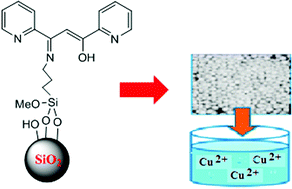New hybrid material based on a silica-immobilised conjugated β-ketoenol-bipyridine receptor and its excellent Cu(ii) adsorption capacity
Abstract
A new hybrid material based adsorbent for the efficient elimination of Cu(II) was synthesized by the immobilization of a new conjugated β-ketoenol-bipyridine ligand receptor onto a silica matrix. The analysis of its surface chemistry was evaluated using a set of suitable techniques. Adsorption studies highlight its surface properties for the excellent removal of Cu2+ (131.82 mg g−1) from aqueous solutions using FAAS. The effect of various parameters, such as pH, initial metal concentration, temperature, competitive extraction, thermodynamics and kinetics, on the adsorption of several heavy metals was investigated via metal extraction from real water samples. The adsorption efficiency increases with an increase in pH and follows pseudo-second-order kinetics. Adsorption is rapid, as evidenced by the achievement of equilibrium within 25 min. Adsorption equilibrium data were well fitted to the Langmuir isotherm model and the maximum monolayer adsorption capacity for Cu2+, Zn2+, Cd2+, and Pb2+ was 131.82, 110, 90.75 and 79.71 mg g−1, respectively. The removal of metals onto the new adsorbent is endothermic and spontaneous in nature. The adsorbent presents high selectivity for Cu2+, in competitive mode, compared to other metals and recent literature reports.



 Please wait while we load your content...
Please wait while we load your content...